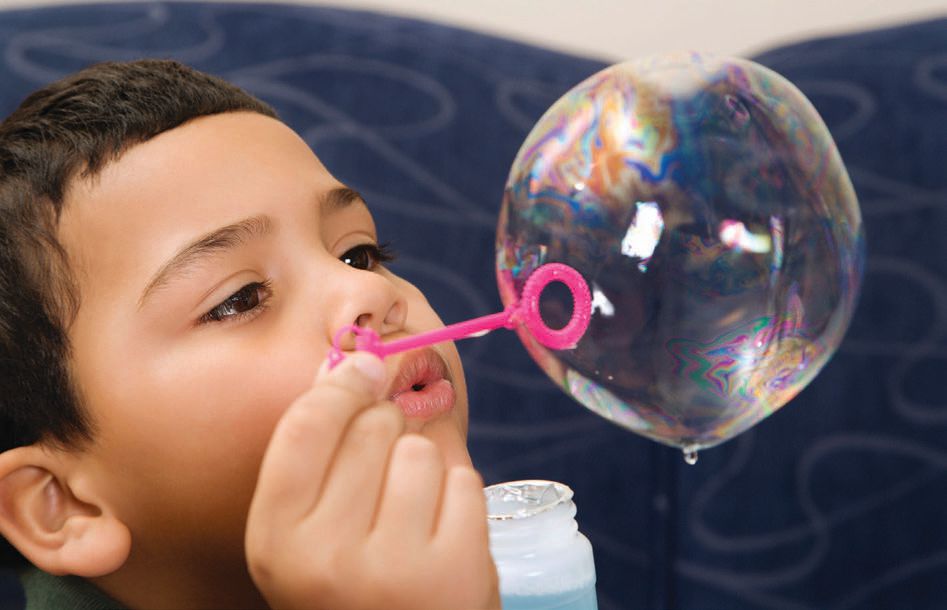Psychedelic Kosmotrope
Evan Zabawski | TLT From the Editor June 2015
The science of the perfect bubble.

Thicker fluids do not always produce thicker bubble walls; wall thickness relates to surface tension and not viscosity.
www.canstockphoto.com
CHILDREN LOVE TO PLAY WITH BUBBLES. They can be mesmerizing; their simplistic form, near defiance of gravity and kaleidoscope of colors can make even adults stop and smile. One aspect we seldom take time to contemplate in our observations is how to create these bubbles at home. Most parents simply purchase premade solutions that result in varying degrees of success, but some try to prepare homemade recipes.
The basic recipe is water, surfactant and a polymer. Tap water is usually sufficient (avoid distilled or purified water), the surfactant is typically in the form of dishwashing liquid (which contains sodium laureth sulfate as both a detergent and surfactant) and a polymer powder like guar gum or polyethylene glycol (PEG). Some readers may note the absence of glycerine, commonly cited instead of a polymer.
Apparently, according to the soap bubble fanciers (they exist), glycerine is the ingredient of the novice. The misconception is that it makes bubbles stronger and longer-lasting, but the bubble-making community has concluded via experimentation that the effects are negligible on large bubbles. Glycerine has a noticeable effect on small bubbles but only when dosed upward of 30% by volume.
Glycerine is a sweet-tasting petrochemical used as an artificial sweetener in foods (often listed as food additive E422), and as a humectant (opposite of desiccant), with some lubricating quality in medicines and skin and hair care products. It is a non-ionic kosmotrope, a co-solvent that competes with water-water hydrogen bonds, that historically was used as an automotive antifreeze before being replaced with the lower freezing point and more toxic ethylene glycol.
The rationale for the addition of glycerine to bubble solution is that its effect is related to viscosity. For reference, the viscosity of pure glycerine is equivalent to an ISO VG 220 lubricant with a viscosity index of less than zero, and a 50/50 mixture with water has a viscosity equivalent to an ISO VG 5 lubricant. Even bubble makers that eschew glycerine in favor of guar gum have incorrectly assumed that viscosity plays a major role. After all, guar gum has about eight times the thickening potency of cornstarch and shows high low-shear viscosity but is strongly shear-thinning. Thicker fluids do not always produce thicker bubble walls; wall thickness relates to surface tension and not viscosity.
Higher surface tension imparts self-healing properties that allow a bubble to split rather than break, as well as adding suppleness or stretchiness, which allows a bubble to deform rather than burst. Surface tension seems to be improved most by the addition of a polymer to the water/surfactant mixture, though the science isn’t entirely understood within the community.
Trial and error testing has shown higher molecular weight PEG polymers on the order of 4,000,000 are preferable. However, the overall chain length and orientation of the monomers can vary significantly between polymers of similar molecular weight. PEGs do exhibit kosmotrope-like properties, but it is not known if that is the primary reason they seem to work better. Certainly the answer seems to be chemical, perhaps even at the molecular level.
The old adage is that “a poor workman blames his tools,” but perhaps the opposite can be applied to bubble making. Those of us who are merely novice bubble makers give little consideration to the actual bubble solution and probably submit to the typical wands for creating bubbles. The more talented bubble makers tend to supply their own concoction, while using a coarse string suspended between two sticks and are capable of making bubbles big enough to envelope a person. Better tools do seem to create better bubbles.
 Evan Zabawski, CLS, is the senior reliability specialist for Fluid Life in Edmonton, Alberta, Canada. You can reach him at evan.zabawski@fluidlife.com
Evan Zabawski, CLS, is the senior reliability specialist for Fluid Life in Edmonton, Alberta, Canada. You can reach him at evan.zabawski@fluidlife.com.